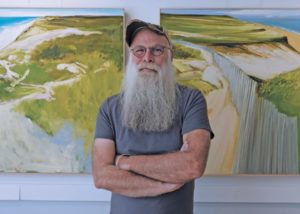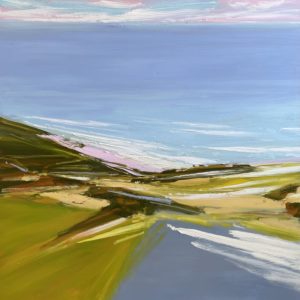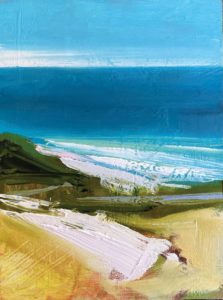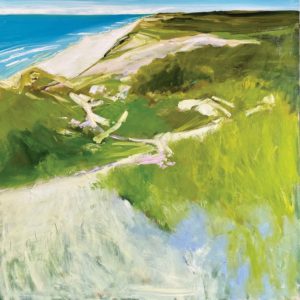Pete Hocking is many things: image maker, teacher, community organizer, blogger, curator — and the possessor of one of the Outer Cape’s most notable beards. “And I’m a big walker,” he says, adding another item to the list. It’s this activity that seems to be the fuel igniting his painting practice.

Hocking’s paintings often depict images that he encounters while hiking along the Atlantic side of the Outer Cape. He is known for gestural paintings of the dunes with slivers of ocean and sky beckoning in the distance. But Hocking doesn’t just want to communicate an image of the landscape. “Painting is an embodied experience,” he says. “The experience of being in the landscape is what I’m trying to bring to the paintings.”
In his recent Verdant, a sandy patch in the foreground is painted aggressively: the surface is scraped down, scratched into, and covered over with layers of paint. Marks dance in the middle distance, describing pathways through patches of dune grass. Zigzagging shapes and lines define the background: a puzzle of sand, beachy foliage, surf, and sky.
The painting, which was recently shown at the Wellfleet Adult Community Center, looked different from when it was shown previously in Boston. “When it came back to me, I put a belt sander to it,” says Hocking, explaining that while the earlier version was more about a surface experience, the current piece connects more to the “elemental stuff going on” in that landscape. He’s satisfied with the result. “I can feel the quality of the day,” he says. Stripping away some of the paint helped to strip away a less authentic response to the landscape.

In translating his own experience of the landscape, Hocking brings the viewer along on his journey. “I’m interested in pathways because I’m a walker,” he says. His paintings are cut through with paths leading the eye through each corner of his compositions. His fluid, juicy brushstrokes communicate kinetic energy, a reflection of Hocking’s interest in “the speed of the body walking through space.” These are paintings that make the viewer work — one is jostled around visually and made to navigate pathways, cliffs, and swathes of beach grass before arriving at the ocean and the relief of a horizon line.
Hocking will be showing paintings where the journey to the water is less arduous in his exhibition “Poseidon’s Kiss” at Four Eleven Gallery. Inspired by a commission where the client wanted more sky and water in a painting, Hocking began exploring different compositions, with the ocean making up nearly two-thirds of one recent painting. But it’s not a serene ocean.

The show’s title relates to Hocking’s understanding of how the ancient Greeks and Romans regarded the power of the sea: “Poseidon was this embodiment of elemental forces,” he says. In a preparatory painting for the series, a clash of directional marks foregrounds the ocean, which stretches out as a deep blue expanse. Nature may offer its comforts, but it’s also fraught with antagonistic energy.
Although Hocking finds his inspiration in the landscape, he doesn’t paint there. He often walks along remote fire roads in Truro, where he lives, to find his material. The treks are not suitable for the large wooden panels he typically paints on.
“There are a lot of limitations to working plein air,” he says. Instead, he uses photography to capture landscapes for later reference and to share with his followers on Instagram. “I’m constantly taking photos of our region and using them as tools for looking, composing things, and color studies,” he says.

Hocking’s Instagram feed — a prolific and candid reflection of his creative process — is a way of extending his creative engagement with the Outer Cape landscape to a larger audience. “I believe in community-embedded arts and practice,” he says. “I don’t just want pictures of this place in the lives of people who can afford very expensive paintings.” He sees his daily photography practice as an anchor in his life.
He adds that he doesn’t translate photographs directly into his work but sometimes uses elements from up to a dozen photos to inform a single painting. While making something in the studio, he also returns to the landscapes that inspire him to “take it all in again.” A change in the way he experiences a place — or simply a change in the weather — may in turn change the studio painting entirely.
Ultimately, Hocking thinks of himself as a picture-maker rather than as a painter or a photographer. Yet whatever the medium or activity, it’s the Outer Cape that he continually returns to in his work: “Part of my practice is writing a very long love letter to this place I fell in love with as a teenager.”
Poseidon’s Kiss
The event: An exhibition of new paintings by Pete Hocking
The time: Sept. 2 to 15; opening reception Friday, Sept. 2, 7 to 9 p.m.
The place: Four Eleven Gallery, 411 Commercial St., Provincetown
The cost: Free
